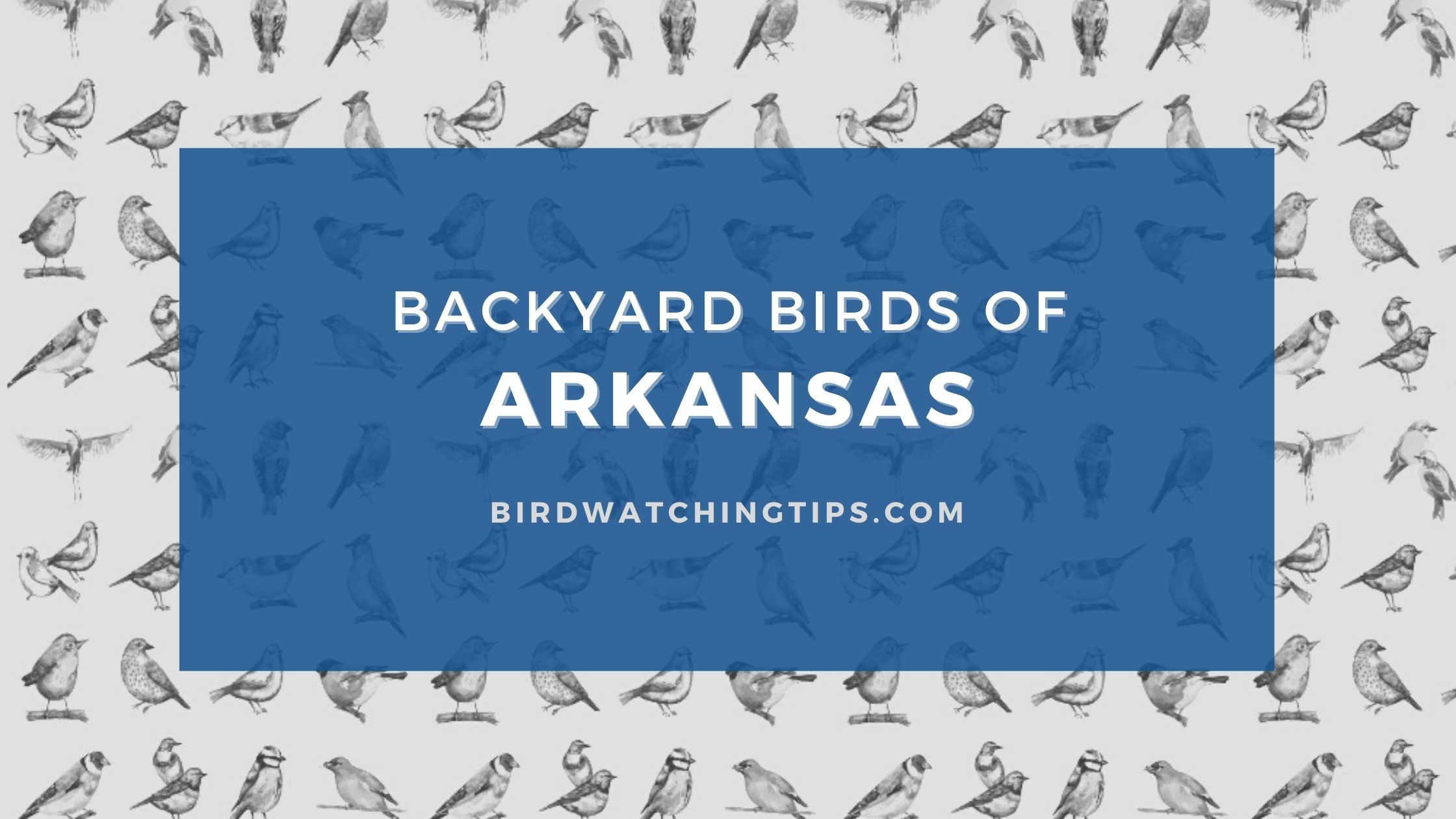One of Arkansas’s many nicknames is ‘The Natural State’ and for good reason. With hot springs, mountains, lakes, bayous, and even river valleys, the state is well-equipped to host a diverse collection of wildlife. This is great news for birders and also the subject of our article today. We’re going to tell you about some of the birds which you can see in Arkansas, as well as where to find them, what they like to eat, and even some tips on crafting that elusive ‘perfect feeder combination’ we all desire. Let’s talk about the popular backyard birds of Arkansas!
3 Categories – 400 Birds
Arkansas is the part and full-time home for a number of Avian species, with the approximate count at 400+. This means that Arkansas birders will have got quite the job ahead of them if they want to spot all of the local birds in their natural habitats. That’s okay, however, because we love spotting these winged beauties and to get you started, we’re going to give you some examples of a few birds which you can see and divide them up like this:
- Year-round Resident birds
- Birds of Spring, Summer, and Early Fall
- Fall and Winter Birds
By the time that we are finished you’ll hopefully know an extra tip or two about some birds that you would like to see or lure and you are going to know the best areas and times to look for them. Let’s get this ball rolling with the year-round resident birds.
Arkansas Year-round Resident birds
These birds, like you, have decided to make Arkansas their home. This means that they can be spotted at any time of the year and in many cases can even be lured directly into your backyard for a feeder-visit. See if you can spot one of these birds this year:
- Pine Warbler
- Eastern Towhee
- Belted Kingfisher
- Loggerhead Shrike
- American Robin
Pine Warbler – Setophaga pinus
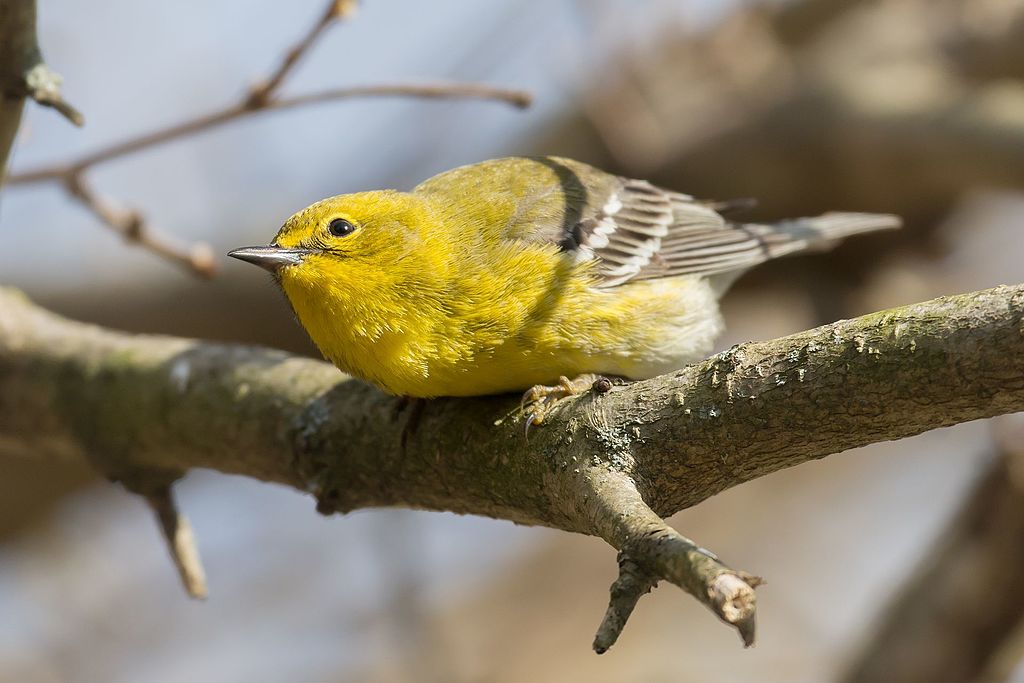
Coloration and Markings: Another bright-yellow bird, Pine Warblers have shaded yellow to olive backs, short gray wings with 2 distinctive wingbars, and medium length gray to white tails. Their breast and underbelly are yellow with olive shading flanking the breast and while the throat and chin, as well as a ring around the back of the neck are pure yellow, the rest of the face is yellow with olive shading which circles the eyes and colors the top of the head. Faint ‘spectacle’ marks may be visible but they are tricky to see and this bird has a short, straight black bill. Females and juveniles may have some of the yellow coloration present but muted a bit, though more often they appear gray and brown.
Size: These birds measure in at 5.1 – 5.5 inches in length with wingspans of 7.5 to 9.1 inches.
Habitat: Found most in Pine forests and deciduous woods, these birds do tend to range and may aso be seen in parks and backyards with well-stocked feeders.
Diet: PBJ time! Chunky peanut butter and just about any jelly will get these bird’s attentions, although you might also have luck with suet, chopped oranges, and oddly enough, Hummingbird feeders. These little guys have quite the sweet-tooth!
Eastern Towhee – Pipilo erythrophthalmus

Coloration and Markings:
Size: Roughly Robin-sized, these birds measure in at 6.8 – 8.2 inches in length with wingspans of 7.9 to 11 inches.
Habitat: These birds love the forest’s edge, especially where there are brush, branbles, thickets, or shrubs. If you have some dense vegetation in your backyard and a feeder, don’t be surprised if an Eastern Towhee moves in. They’ve been known to make some lucky birder’s backyard their home from time to time.
Diet: Cracked corn, milo, peanuts, and oats are all good choices for attracting this bird. Put one or more of them in a ground feeder if you see a Towhee nearby or simply scatter some seeds at the base of your current feeder. You might just get yourself a backyard tenant!
Belted Kingfisher – Megaceryle alcyon
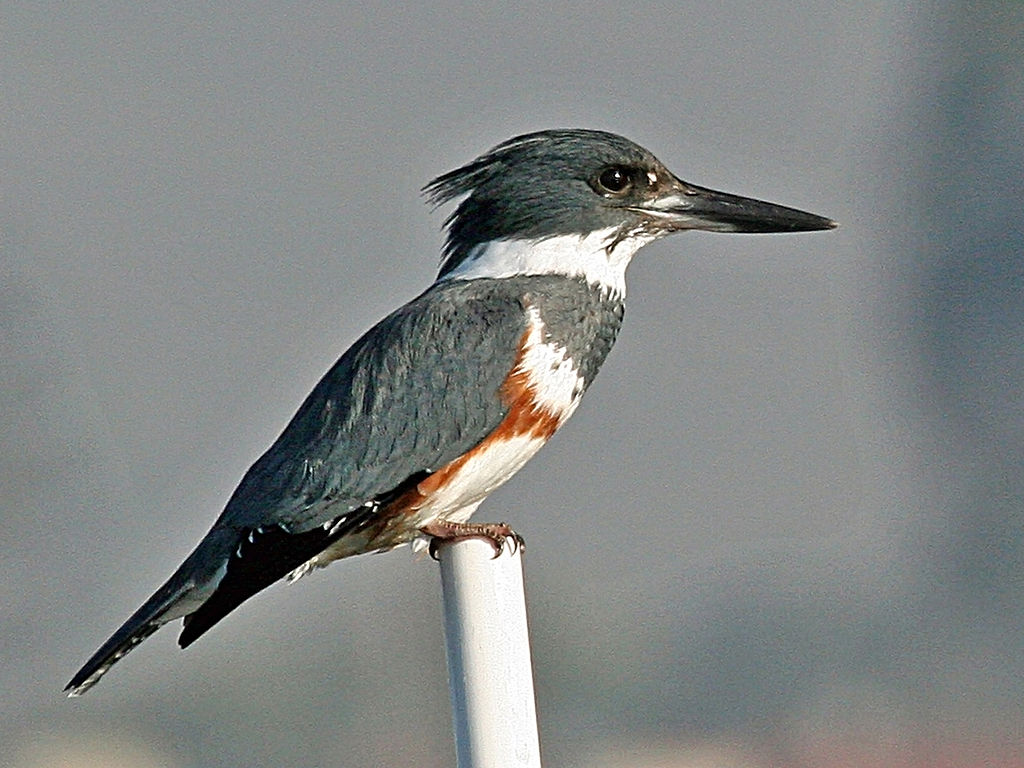
Coloration and Markings: The Belted Kingfisher is a real attention-getter! This top-heavy bird has a gray to dark gray back with short, gray wings which have black feathers as the color approaches the tips. They have short, gray perky tails which have black and white ‘checkerboard’ edging towards the tips and some white underneath coming from the white rump. The breast of this bird is white with a gray ‘necklace’ mark that is thick enough that it almost looks like a gray bandanna and the underbelly of this bird is white with some gray flanking (although females will have a rust-red band just above the belly and some red under the wing). Immature Kingfishers will also have a little bit of red around the breast area. Facially, this bird has a huge, striking dark gray crest and a black ‘bandit mask’ is also present. A white spot is in front of the eye and this bird has a long, straight and powerful black bill.
Size: These birds measure in at 11 – 13.8 inches with wingspans of 18.9 – 22.8 inches.
Habitat: These birds live next to ponds, streams, and rivers and live in burrows in the ground rather than treetop nests. In the winter they tend to pick areas of water that won’t freeze. If your backyard is a few acres (not uncommon in the beautiful state of Arkansas) then look for these birds near the water on your land.
Diet: These birds eat mostly fish but they also go for rodents, smaller birds, and in winter they may look for berries. You can try adding some Blueberries into your feeder but these guys are a little shy. If you have some Blackberries or other berry vines in your yard then this might well do the trick.
Loggerhead Shrike – Lanius ludovicianus
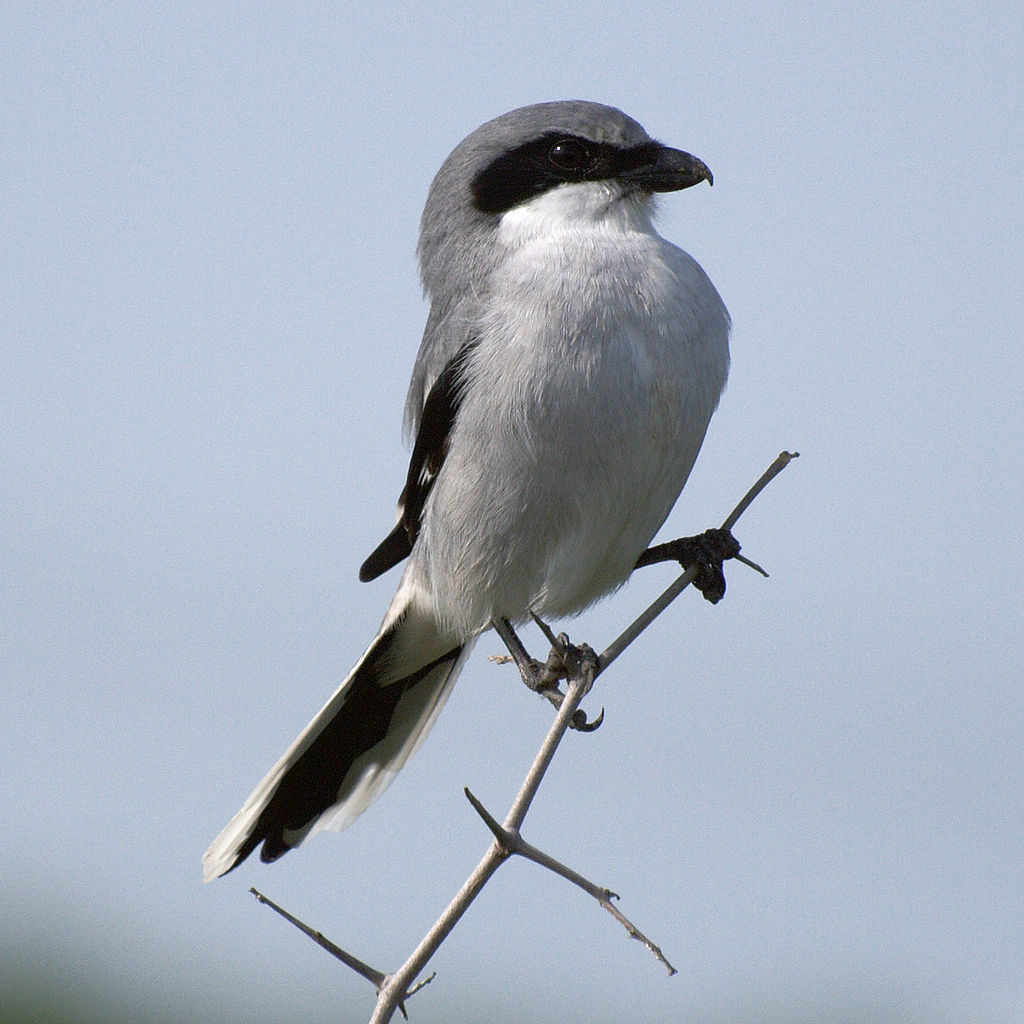
Coloration and Markings: Loggerhead Shrikes look friendly but they are mighty hunters. They have soft, gray backs with long dark gray to black wings. A faint trace of white may be seen when they are at rest and these spots actually look like full wingbars when the bird is in flight. They have long, grayish black tails with white undersides and tips and the breast and underbelly of this bird are snowy white. Facially, this bird has a black mask band which terminate a little before reaching the back of the head and it is white from cheek to chin, with gray outlining in the back and taking up the top of the head over the mask. The birds have stout, hooked gray bills.
Size: These bird measure in at 9.1 – 9.4 inches in length with wingspans of 11,8 to 13.8 inches.
Habitat: These birds love open areas in boreal forests. They can be seen at the forest’s edge sometimes and occasionally in parks.
Diet: These birds like insects, mice, and eating other birds! While you might have some luck with some dried crickets in your feeder these birds are more likely to go after other birds eating there. These are the birds you’ve heard about which are famous for throwing their prey onto dangerous surfaces like barbed wire!
American Robin – Turdus migratorius
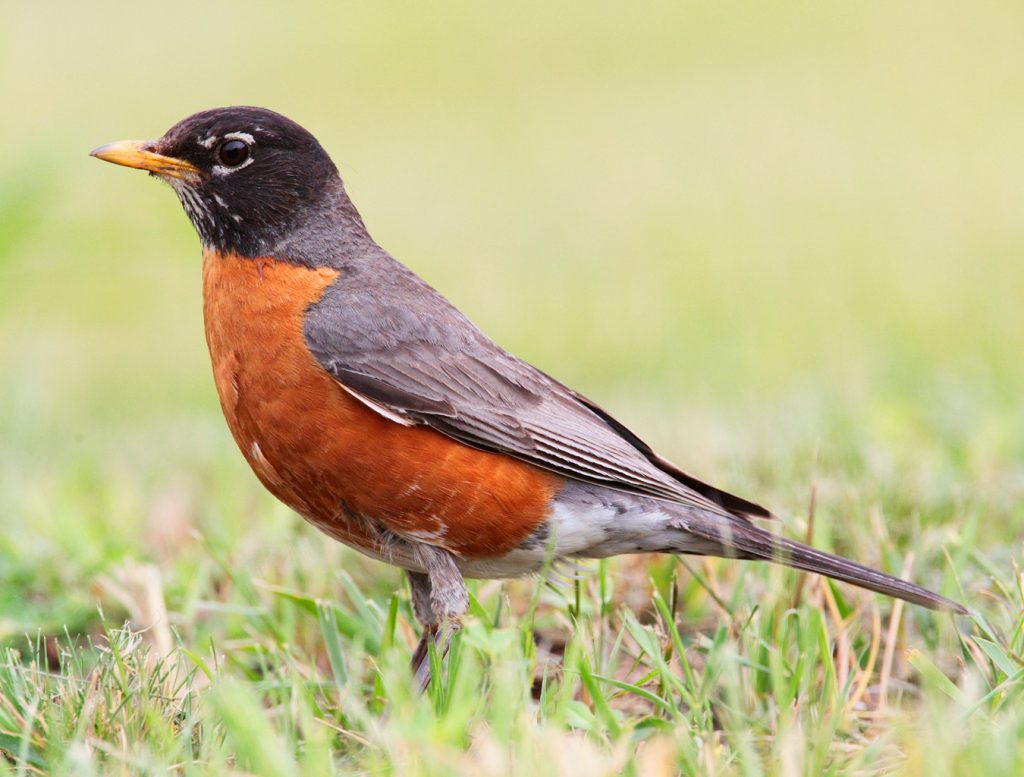
Coloration and Markings: American Robins have grayish-brown backs, with long wings and long tails. The wings are the same grayish-brown with some minute white edging here and there while the tails tend to be a little darker gray, almost back with some white on the underside courtesy of the white rump and a little extended coloration which carries from it. The breast and underbelly of this bird are a dark apricot orange or sometimes red-orange and facially, this bird has a black face which really brings out a distinctive fragmented eyering. A dot of white may be seen above the bill and a few just underneath it but it is quite minimal and this bird has a medium-length, slightly curved yellow bill.
Size: These birds measure in at 7.9 – 11 inches in length and have wingspans of 12.2 to 15.8 inches.
Habitat: When American Robins aren’t spending time in their favored deciduous forests they may be found in many places. Parks, fields, golf courses, and backyards… These birds are not shy of people and as such, will happily visit a well-stocked feeder.
Diet: Chopped apples and dried mealworms are an easy offering that you can use to attract these birds.
Arkansas Birds of Spring, Summer, and Early Fall
When the daffodils and the violets start blooming and the birdsong competition begins then you know that spring has arrived in Arkansas. This is when the fun starts as many new birds arrive and a number of them will stay through until summer or even fall. See if you can spot some of these amazing birds during this time:
- Rose-breasted Grosbeak
- Indigo Bunting
- Summer Tanager
- Prothonotary Warbler
- Blue Grosbeak
Rose-breasted Grosbeak – Pheucticus ludovicianus

Coloration and Markings: Male Rose-breasted Grosbeaks have black backs and long, black wings sporting a white wingbar on each and a handful of assorted white spots. They have long, black tails with white on the outer edges and the undersides and the breast and underbelly of this bird are white with the exception of a brilliant rosy-red chevron mark which goes from the throat to the middle of the breast. Facially, this bird has a black face with a large, stout ivory bill. Females and juveniles look quite a bit different, with brown coloration and heavy streaking, as well ad a long, white eyebrow stripe.
Size: These birds measure in at 7.1 – 8.3 inches in length with wingspans of 11.4 to 13 inches.
Habitat: These birds love coniferous and deciduous woods and are often spotted in flocks at the forest’s edge.
Diet: You can attract Rose-beaked Grosbeaks by adding a few choice items to your feeder. Safflower and Black Oil Sunflower seeds are two of their favorites and the addition of peanuts will further increase your odds of getting their attentions.
Indigo Bunting – Passerina cyanea

Coloration and Markings: Male Indigo Buntings are stunning and hard to miss. They are completely a deep Indigo blue, with richer coloration on the face and with medium-length, conical silver bills. Females look a bit difference, being mostly brown with some streaking, a white throat, and the smallest touches of blue are often present on the tail, wings, and rump. Juvenile male Buntings will have a denser mix of blues and browns until they mature.
Size: These birds measure in at 4.7 – 5.1 inches in length with wingspans of 7.5 to 8.7 inches.
Habitat: Indigo Buntings have a fondness for dense vegetation, spending much of their foraging time in brambles, thickets, weedy fields, and shrubs.
Diet: Nyjer thistle and dried mealworms are an easy and excellent way to get the attentions of the beautiful Indigo Bunting.
Summer Tanager – Piranga rubra
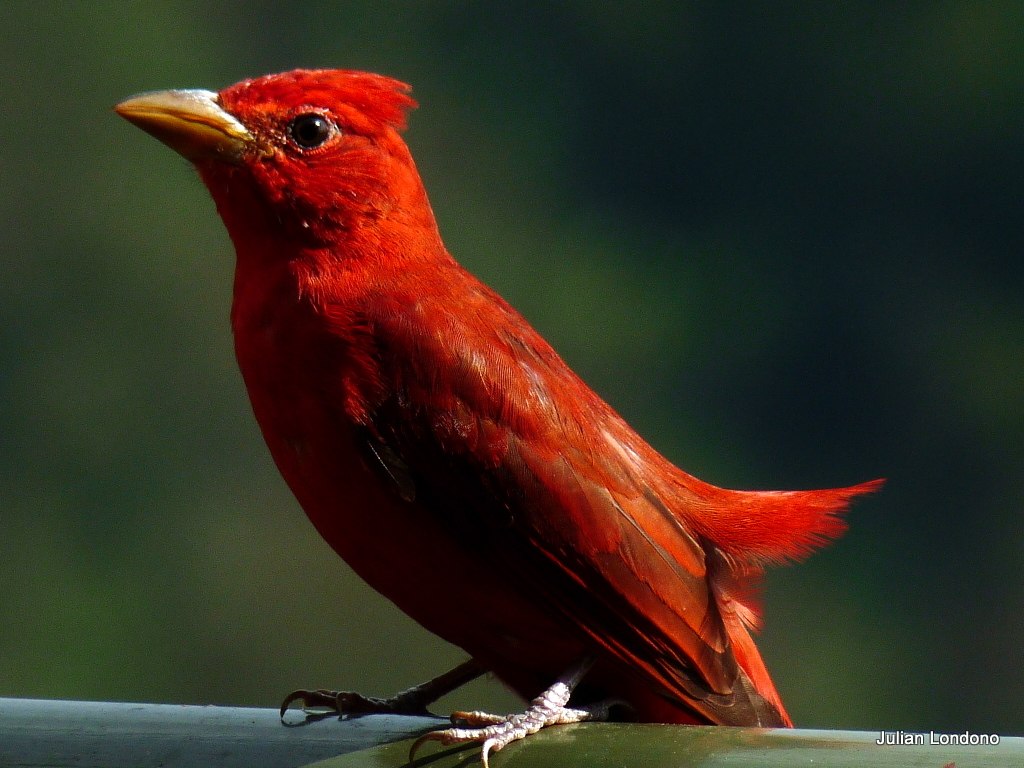
Coloration and Markings: Summer Tanagers are a sight to behold, with the males being completely strawberry red. They have medium-length, slightly curved dim yellow bills and the females and juveniles display as yellow-green, with heavier yellow concentrations in the face.
Size: These birds measure in at approximately 6.7 inches from head to tail and have wingspans of 11 to 12 inches in length.
Habitat: These birds are fond of mixed-pine forests as well as deciduous ones, though they will range out to visit parks and the occasional backyard.
Diet: While these birds mostly eat insects they will go after the occasional fruits or berries. Try leaving out some chopped apples and Blueberries for them and they might just take the bait. If you have any fruiting trees or vines then this might attract them as well.
Prothonotary Warbler – Protonotaria citrea
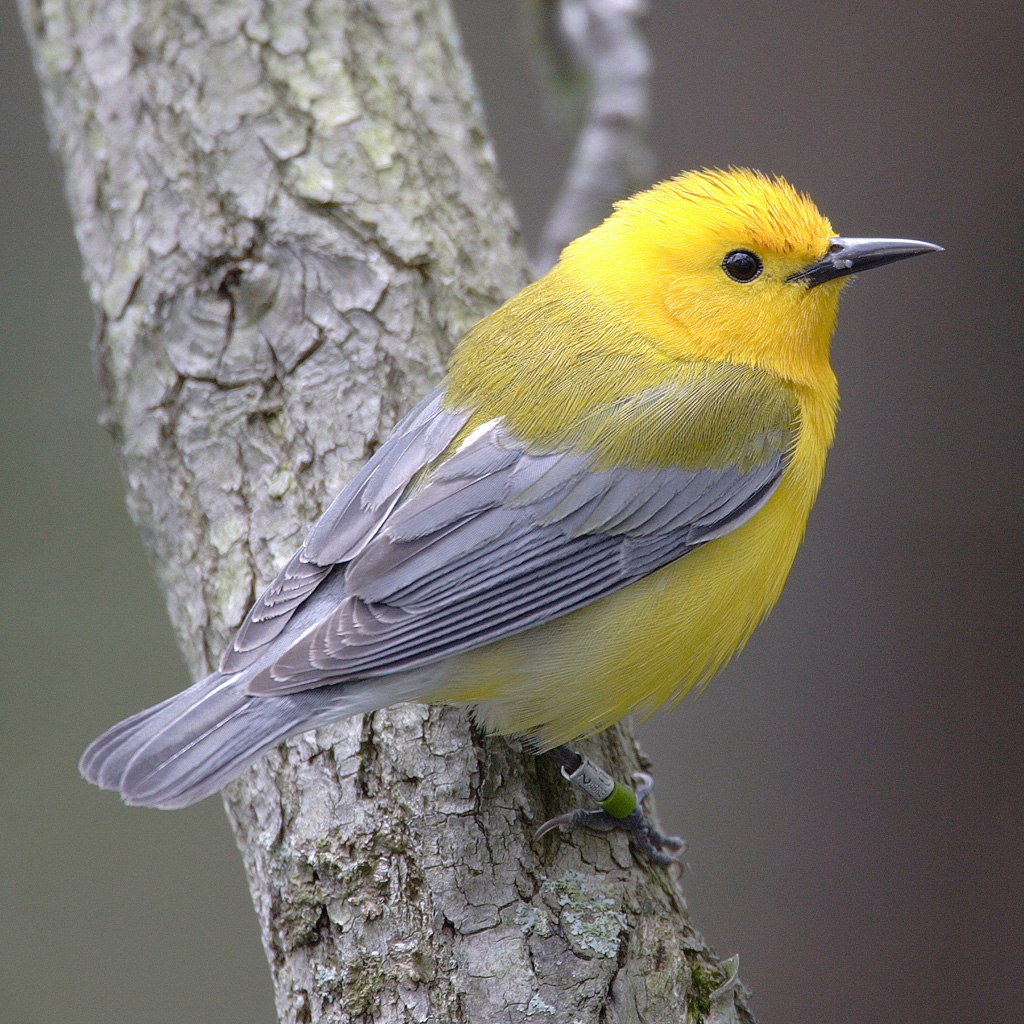
Coloration and Markings: The Prothonotary Warbler is a bright, cheery little bird. It has a dark-shaded yellow back, with medium-length, steely gray wings and a long, blue-gray tail which is white on the underside. The breast and underbelly of this bird are a bright or bright, but shaded yellow color and facially, starting from just under the throat and taking up the head completely this bird is a stunning bright yellow. The Prothnotary Warbler has a long, thin bill that will be pale or almost completely black. Females look much the same but will be a lighter yellow than the males.
Size: These little rays of sunshine measure in at approximately 5.1 inches in length with wingspans averaging 8.75 inches.
Habitat: These birds love foraging near water, so look for them in marshes, around streams of ponds, or areas which are prone to flooding.
Diet: In spring these birds eat insects almost exclusively, however, as fall and winter approach these birds become less picky and will settle for seeds and berries. Try leaving out some Nyjer thistle mixed with hulled Black Oil Sunflower seeds and a side of blueberries or chopped cherries.
Blue Grosbeak – Passerina caerulea
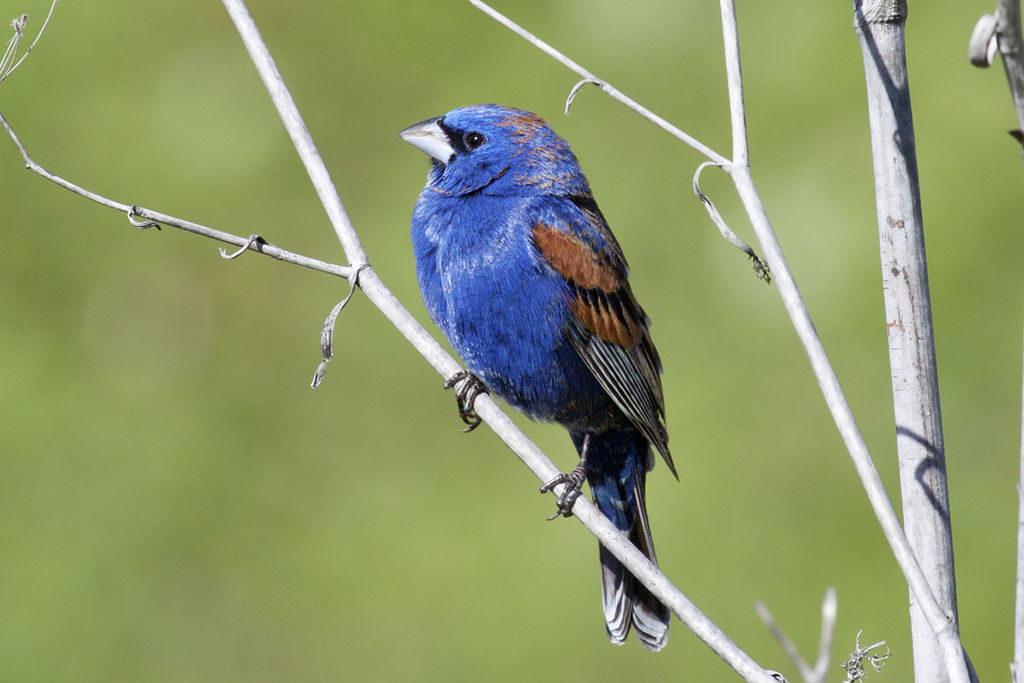
Coloration and Markings: Blue Grosbeaks have deep blue backs and medium-length blue wings with 2 waxy pinkish-red wingbars and pink-red half circles accenting the blue by displaying in a descending manner on the feathers close to the back. They have long bluish tails and the breast and underbelly are also a deep blue. Facially, the blue color is at it’s richest, broken only by a small, black mark and an enormous, curved silver bill. Females will have the same markings but will be mostly a cinnamon-brown mix with the richest coloration above the eyes.
Size: These birds measure 5.9 – 6.3 inches from tip to tail and have an average wingspan of 11 inches.
Habitat: These birds like open areas with dense vegetation and at least a few trees. Untended fields close to the woods are a good place to look for the Blue Grosbeak and as well as dense shrubbery around ponds and streams.
Diet: Black Oil Sunflower seeds, chopped Pine nuts, and cranberries are all favorites of this bird and may tempt them to get a closer look at your backyard feeder. Give it a try and see for yourself!
Arkansas Fall and Winter Birds
Arkansas winters will sometimes drop below freezing but are fairly mild for the most part. They also have a lot of active birds out there enjoying themselves, ranging out into parks and backyards and looking to see if you’ve left something out for them. Be sure to stock up your feeders to help out one or more of these fine feathered fellows:
- Brown Creeper
- Dark-eyed Junco
- Blue Jay
- American Goldfinch
- European Starling
Brown Creeper – Certhia americana
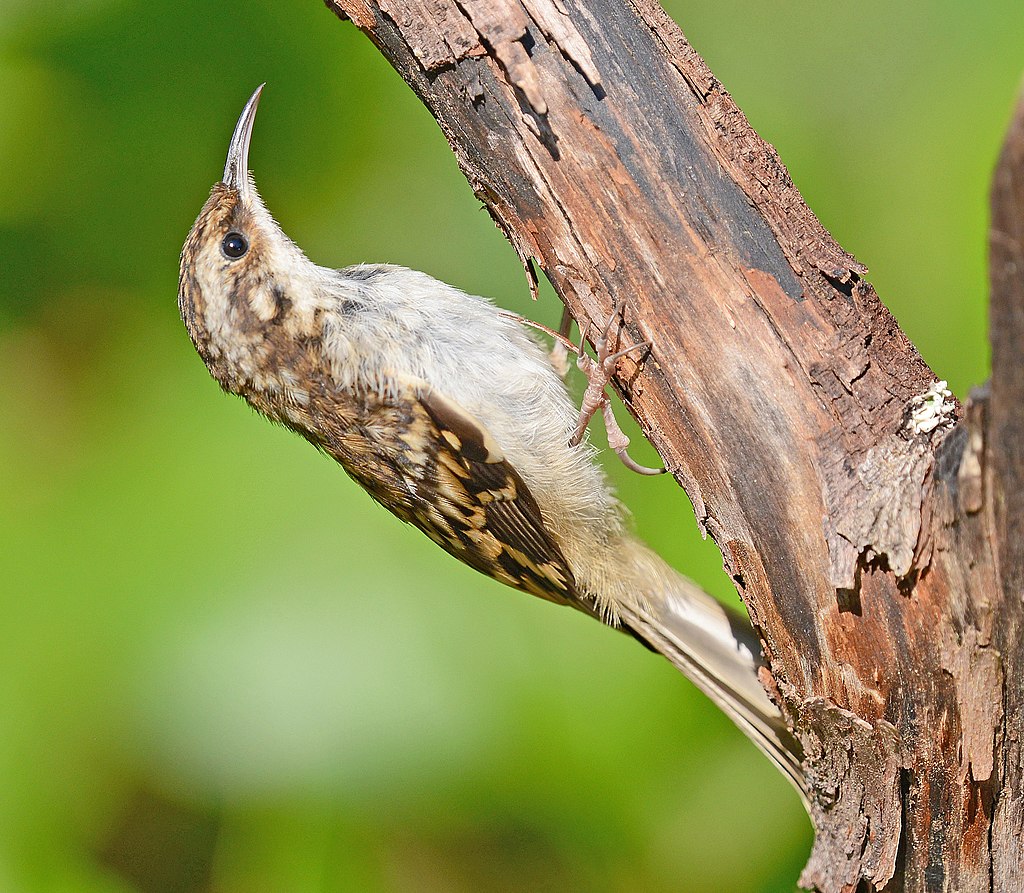
Coloration and Markings: Brown Creepers are cute little birds, with buff and brown streaked backs and with wings of the same patter until you get closer to the tips, where a large portion of the wing has black and white stripe patterns. The tail of this bird is long and brownish-tan and the breast, underbelly, and rump of this bird are paper white. This white continues up into the face, stopping under the bill and extending horizontally to a space just behind the eye. A brown stripe goes over the eye and extends a bit down to the cheek, while the top of the head is streaked buff and brown.
Size: These little guys and gals measure in at 4.7 – 5.5 inches from head to tail-tip and have wingspans of 6.7 to 7.9 inches.
Habitat: These birds love Evergreen forests but may also be found in Evergreen-deciduous mixed woods. In winter they become less picky and may be seen in many types of forests, as well as parks and the occasional backyard.
Diet: These birds mostly eat insects but you can sometimes get their attentions with some hulled Black Oil Sunflower seeds mixed up with a little cracked corn.
Dark-eyed Junco – Junco hyemalis

Coloration and Markings: Dark-eyed Juncos have a s simple, yet lovely coloration. Their upper bodies will be brown or smooth gray on the back, wings, and the top of the long tail. Underneath the tail you will see white and the breast and underbelly of this bird are white as well, with a heavy gray flanking on the breast which thins down as the color approaches the underbelly. This gives an appearance when the bird is at rest of all of the upper gray stopping just under the wing evenly across the underside of the bird. Much like someone gave it a quick dip it white paint. The face of this bird is the deepest brown or gray and it has a distinctive medium-length, conical pink bill.
Size: These birds measure in at 5.5 – 6.3 inches in length with wingspans of 7.1 to9.8 inches.
Habitat: These birds love coniferous forests but will settle for those that are mixed coniferous. They are also frequent visitors to parks, fields, and backyards, so be sure to leave a little something out for them and you might just get a visit!
Diet: Three easy favorites of the Dark-eyed Junco that you can add to your feeder are cracked corn, Black Oil Sunflower seeds, and White Proso millet.
Blue Jay – Cyanocitta cristata
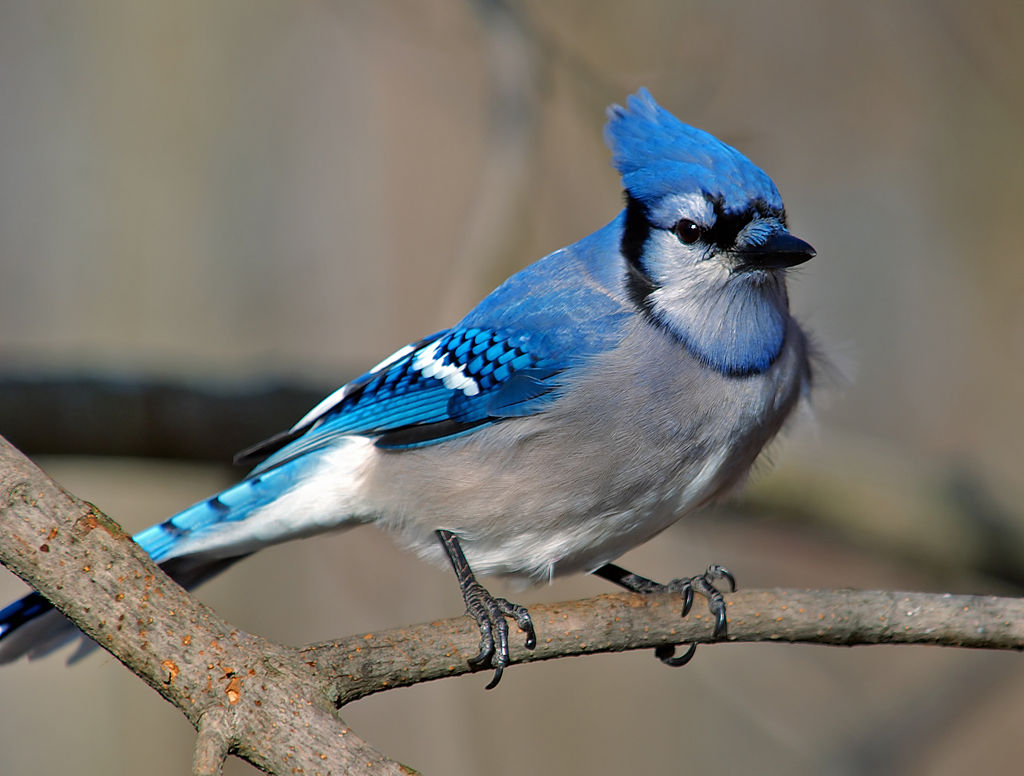
Coloration and Markings: Blue Jays are one of those birds that you almost never tire of seeing. These birds have light blue backs and long, blue wings with black-outlined blue scale patterns, a white wingbar on each wing, and various black-outlined white squarish spots further down. They also have long tails which have a symmetrical pattern of light blue square-pairs outlined in dark blue, with a touch of black at the tip and white undersides. The breast and underbelly of this bird are snow-white and so is most of the face, with some few exceptions. First, the Blue Jay has a large, beautiful blue crest at the top of it’s head and a black line comes down from its termination at the back of the head and encircles the throat to complete at the crest on the other side. Finally, this bird has a small mask that looks a bit abstract, with zigzagging lines, and the look is completely by a long, straight black bill.
Size: These birds aren’t small, measuring in at 9.8 – 11.8 inches in length and with wingspans of 13.4 to 16.0 inches.
Habitat: Blue Jays spend a lot of time at the forest’s edge and particularly favor Oak trees for their delicious acorns. They are not afraid of towns or cities and may be seen on phone lines and fences as they scout the area for something tasty.
Diet: An easy mix that Blue Jays love is cracked corn and peanuts. Give it a try and be sure that you’ve got a large feeder or other feeding receptacle, as these are good-sized birds!
American Goldfinch – Spinus tristis

Coloration and Markings: The American Goldfinch has a bright yellow back and black wings, with a white wingbar close to the shoulder and another wingbar a little lower down. Further down the wing there are some vertical and assorted white markings that carry into the short, notched black tail. This tail has a white patch underneath it, as well, coming from the white rump while the breast and underbelly of this bird are bright yellow like the back. The richest yellow will be the bird’s head, with the only contrast being the bird’s dark eyes, conical orange bill, and it’s telltale black cap that goes from the center of the head to the bill. Females tend to be olive on the upper body and a dimmer yellow on the lower and in the winter you can still spot these birds if you look for their now-dimed wingbars. Their winter plumage won’t be yellow, but brown!
Size: These little guys measure in at 4.3 – 5.1 inches from head to tail and have wingspans of 7.5 to 8.7 inches.
Habitat: American Goldfinches love brambles, thorns, thickets, and shrubs but they also like to forage in areas prone to flooding. These birds regularly visit parks and backyards so be sure to let them know that you are thinking of them by leaving out something tasty.
Diet: A simple mix of Black Oil Sunflower seeds and Nyjer thistle is all you need to potentially lure tese little rays of sunshine into your backyard. Be ready, though, as they sometimes bring friends!
European Starling – Sturnus vulgaris
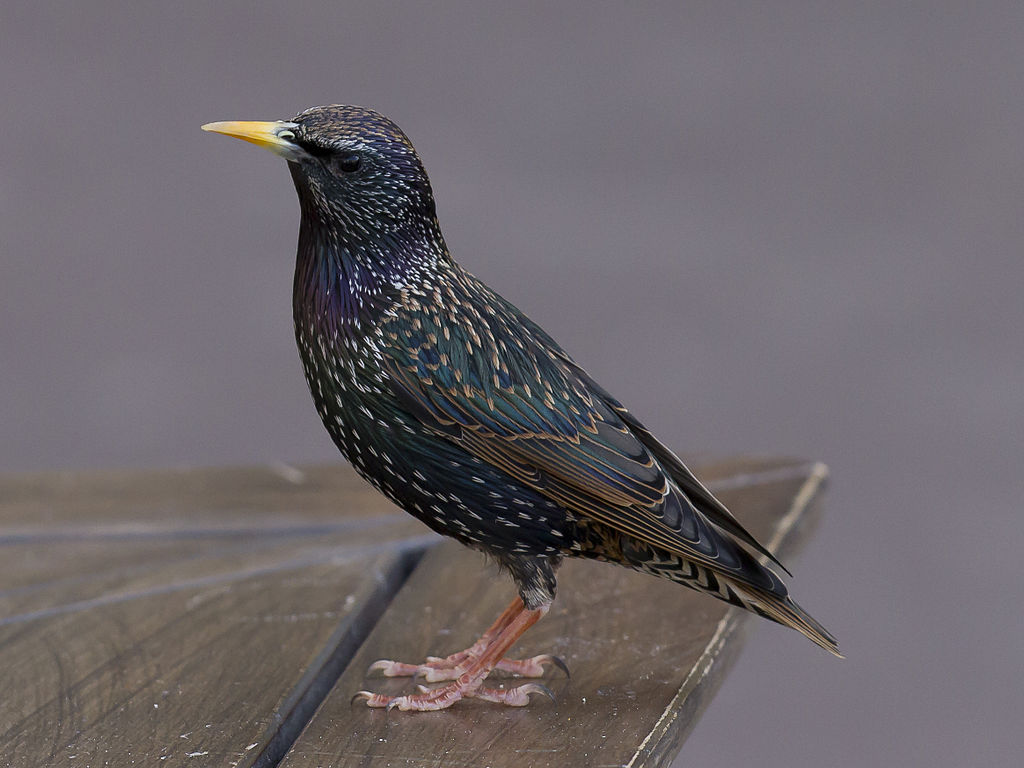
Coloration and Markings: The European Starling has a shiny purple-green coloration all over it’s body. This bird has long wings and a long tail and facially, you can’t miss its distinctive long and straight yellow bill. In the winter, these birds look sharp in their fancy new plumage of brown with white spots and if you haven’t seen it before you should definitely look for it. It’s a sight to see!
Size: These birds measure in at 7.9 – 9.1 inches in length with wingspans of 12.2 to 15.8 inches.
Habitat: Brought to North America a long, long time ago by fans of Shakespeare, European Starlings are quite comfortable in the suburbs and may be seen just about anywhere around the city. They also like farms and are sometimes viewed as a bit of a nuisance as they are smart enough to raid granaries as well. They will happily visit your backyard if you leave them something out.
Diet: These birds love fruits, grains, and seeds. You can leave out a little oats and what, Black Oil Sunflower seeds, and White Proso millet with some raisins mixed in. These are all favorites of this Starling and might just make you a new friend who’ll make regular visits!
Supporting cast (Other Backyard Birds of Arkansas that might pay you a visit)
Our ‘Supporting Cast’ category is an extra roster of Avian stars that are out there year-round and ready to perform for you! These birds are dedicated to spending their lives in the same state that you do and if you leave a little something out then you might make a long-time friend. We’ll tell you where you can spot them and after that, let’s see if you can catch a glimpse of one or more of the following birds this year:
- Tufted Titmouse
- Downy Woodpecker
- Mourning Dove
- Northern Cardinal
- Eastern Bluebird
Tufted Titmouse – Baeolophus bicolor
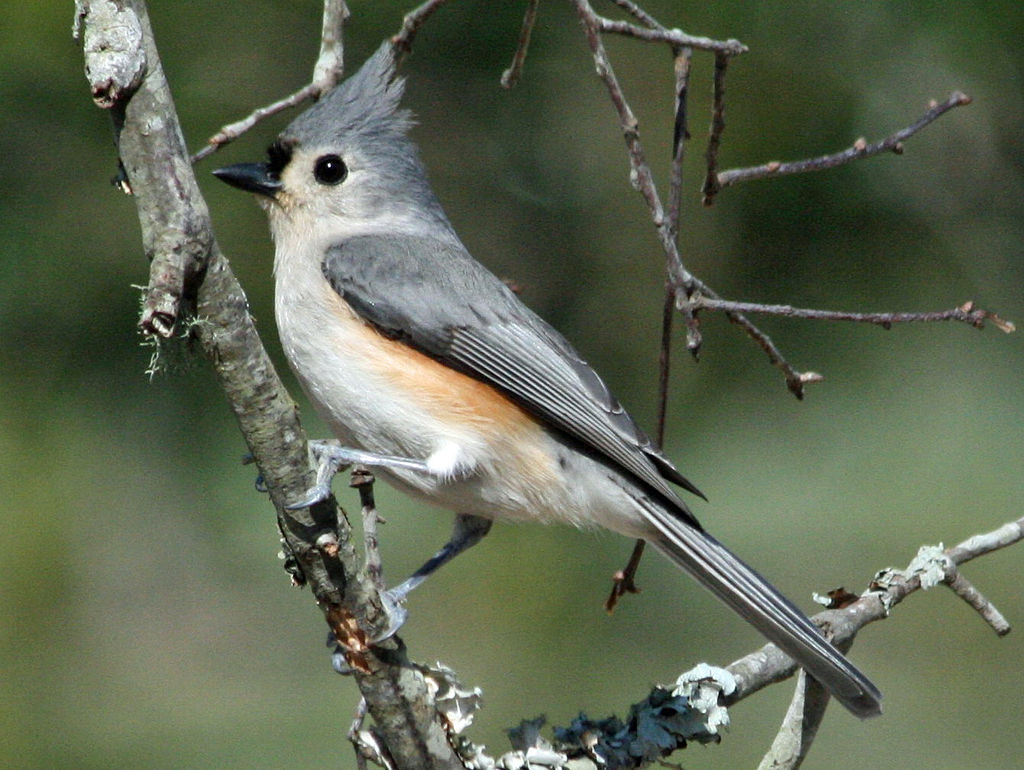
Coloration and Markings: The Tufted Titmouse has lovely grayish-blue coloration on its back, wings, and long tail. The breast and underbelly of this bird are paper-white and this white coloration moves up to fill most of the face. The exception to this is a soft blue-gray crest with some blue-gray color framing the top half of the eyes and moving down the neck to terminate just over the cheek. This bird has a small, stout bill and a distinct, black square marking will be right above it.
Size: These birds measure in at 5.5 – 6.3 inches in length with wingspans of 7.9 to 10.2 inches.
Habitat: These birds love Evergreen and deciduous woods but also have a fondness for orchards, parks, and backyards with stocked feeders.
Diet: The Tufted Titmouse loves acorns but you can also attract them with suet, peanuts, and Nyjer thistle.
Downy Woodpecker – Picoides pubescens
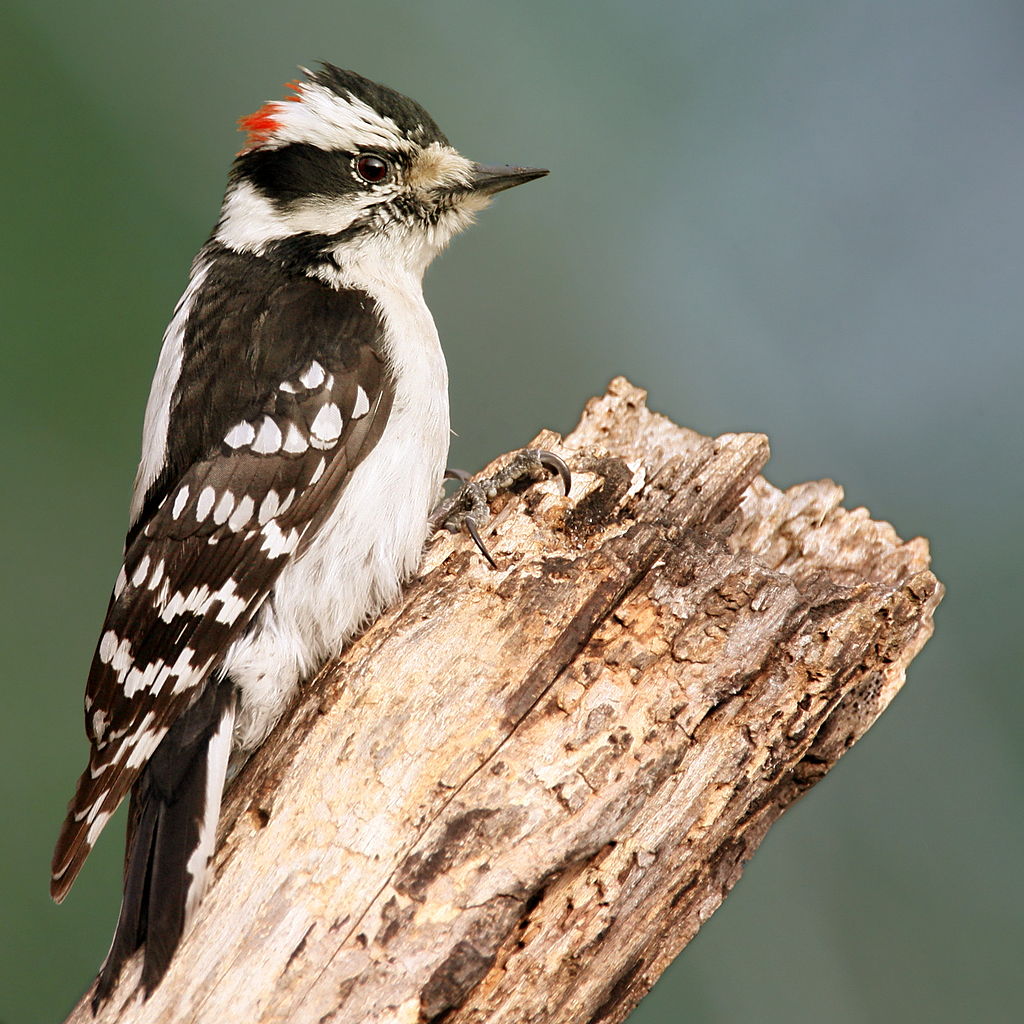
Coloration and Markings: Downy Woodpeckers are lookers, with white backs and long, black wings with stripes composed of white dots which give the wings a checkered effect. They have medium-length black tails with some white spots on the outer feathers and the breast, underbelly, and rump of this bird are snowy white. The Downy has a white face with a few exceptions, such as a black mustache line, a black ‘bandit mask’, and a thin, black cap which terminates at the back of the head with a red spot on males (staying black for females). These birds have thin, medium length black bills.
Size: These birds measure in at 5.5 – 6.7 inches in length with wingspans of 9.8 to 11.8 inches.
Habitat: These birds love open areas of the woods, such as copses or meadows, and favor the deciduous variety whenever possible. They also feel comfortable anywhere there is dense vegetation, sych as high weeds, shrubs, thickets, and brambles. Downy Woodpeckers range out a lot, visiting parks and backyards frequently so keep an eye out and some snacks close (for both you and the bird!).
Diet: These birds like lots of foods but you can get some good mileage with suet, cherries, and Black Oil Sunflower seeds. Try these or simply suet with your own seed and berry combo and you might just get this Woodpecker’s attention.
Mourning Dove – Zenaida macroura
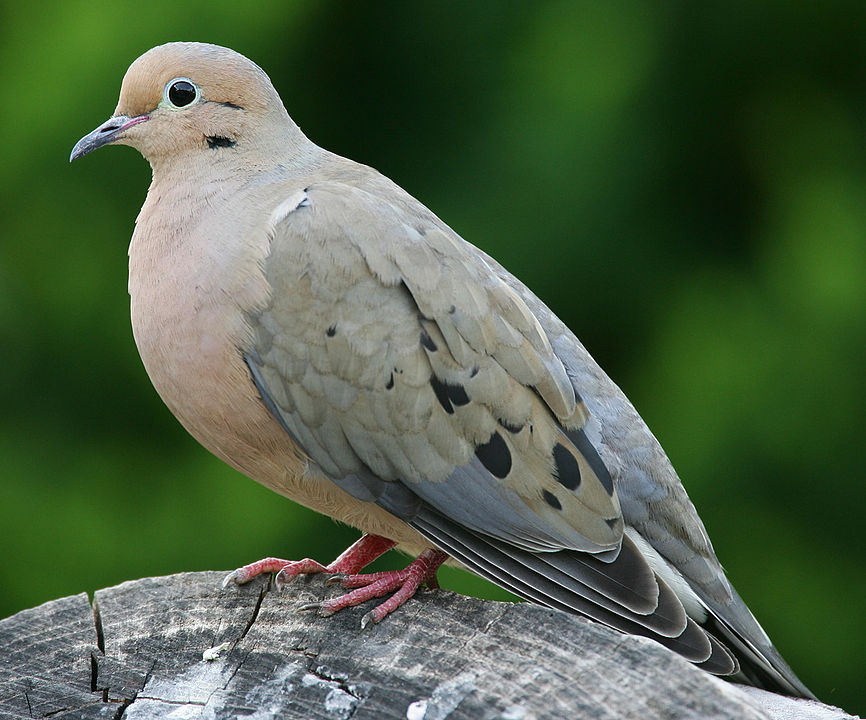
Coloration and Markings: Mourning Doves tend to be gray or grayish brown on their backs, wings, and their long tails. The wings will show a deep saturation of creamy tan color as well as some distinct black spots towards the center. The breast if this bird is white with heavy tan which lessens in intensity as it approaches the underbelly. Facially, the tan is most concentrated and you will notice a clear, telltale eye-ring that finalizes the identification. This bird has a medium length, straight black bill.
Size: These birds measure in at 9.1 – 13.4 inches in length with wingspans of approximately 17.7 inches.
Habitat: These birds love open areas, so you are most likely to see them at a forest’s edge, a meadow, field, or simply on the bare ground. Mourning Doves are well acclimated to the city as well and may be seen on phone wires, fences, or munching happily at backyard feeders.
Diet: Cracked corn, wheat, and Black Oil Sunflower seeds are great lures to get the Mourning Dove to pay attention to your feeder.
Northern Cardinal – Cardinalis cardinalis
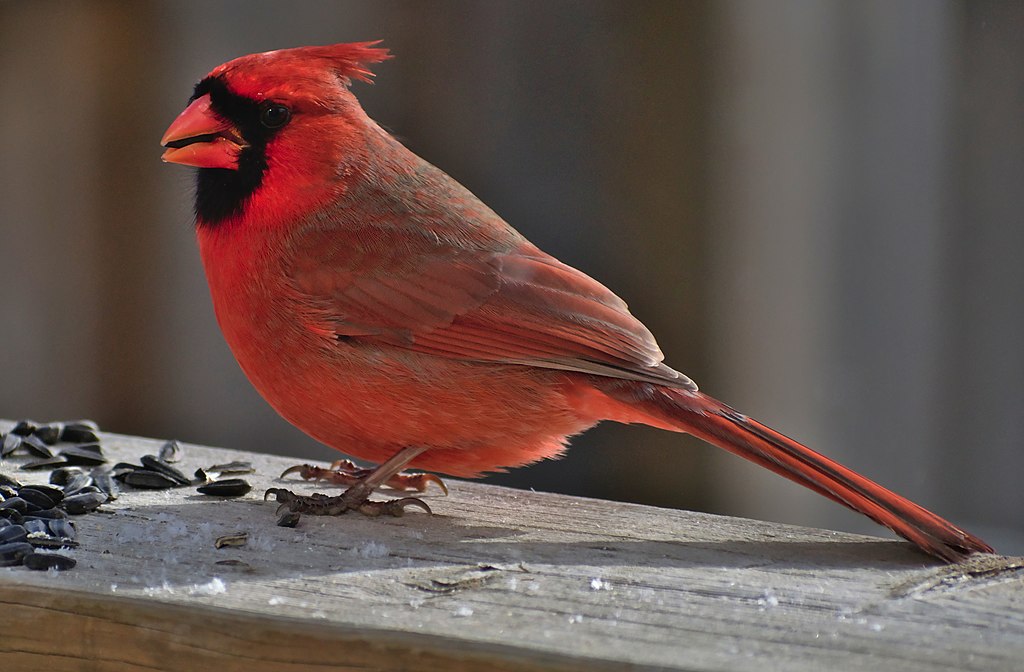
Coloration and Markings: Northern Cardinals are almost completely red, with some grays showing on occasion when they are molting. Facially, you’ll see the richest red and the color variations which are present on this bird. These include a black mask that pulls down to sharply fill the area underneath the bill in a shape like a villain’s goatee. You will also notice a large, conical orange bill and looking up this bird has a brilliant red crest that you cannot miss. Females, by contrast, tend to be a smooth, light brown, with touches of red throughout the plumage.
Size: These birds measure in at 8.1 – 9.1 inches in length with a wingspan of 9.8 to 12.2 inches.
Habitat: These birds like to nest in dense vegetation, such as brambles, thickets, and shrubberies, but when they roam they favor parks and backyards.
Diet: Suet, cracked corn, peanuts, and assorted berries might just win the heart of a local Cardinal. Give these a try and see what happens!
Eastern Bluebird – Sialia sialis
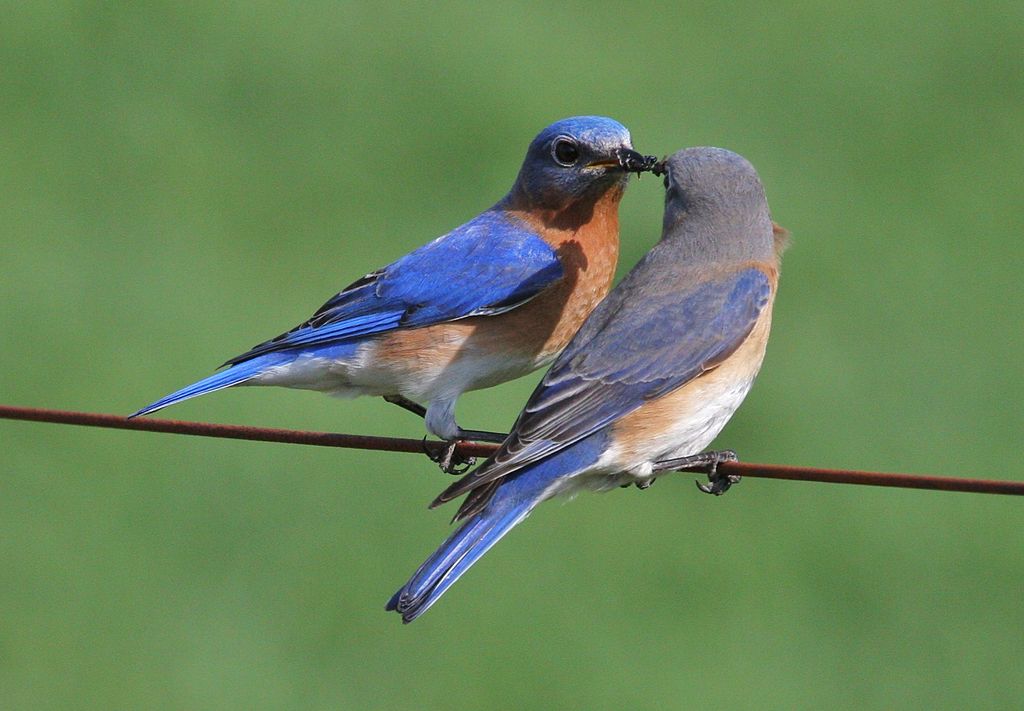
Coloration and Markings: Eastern Bluebirds have deep blue backs, medium-sized blue wings, and short blue tails. These tails are white on the underside and this bird has a white rump as well while the breast of this bird is orange or red-orange. This coloration goes down to the white underbelly, flanking the sides like a vest, and the orange coloration from the breast continues up to about cheek level, crossing over the top of the wing horizontally to terminate at the back of the neck. The rest of this bird’s face is blue and it has a short, straight black or brownish bill.
Size: These birds measure in at 6.3 – 8.3 inches in length and have wingspans of 9.8 to 12.6 inches.
Habitat: These birds love meadows and copses, being fans of open areas in Nature, but it’s not uncommon to see them at golf courses, roadsides, and backyard feeders when they go looking for snacks.
Diet: Eastern Bluebirds love mealworms, suet, and broken-up Black Oil Sunflower seeds. They will also eat a bit of crushed eggshell if you’ve got it and this presumably helps to aid in their digestion.
Arkansas Bird Buffet
Every year we set up our feeders and hope for that magical combination which will bring the most birds to visit. Today we’ve got some advice in regards to Arkansas birds from ourselves and from the University of Arkansas Cooperative extension. They have some advice on good feeder foods and some other tips on the subject, so if you want to read a little further just take advantage of the reference link we have listed at the end of the article. In the meantime, here are some summarized feeder recommendations that can help you to lure a wide range of birds:
- Sunflower chips
- Peanut chips
- Raisins
- Orange halves
- Cracked Corn
- Suet
- White Proso millet
- Grape jelly
- Dried crickets
Arkansas Birding Hot Spots
The Chirparazzi have their hands full in Arkansas as they stalk the elusive winged celebrities for sightings and well-timed photos. If you would like to do this yourself like a true Chirparazzo then there are a few ideal places that you can look when you are out of the house. If you don’t find anything close, we have a reference link that can help to map something a little more convenient but in the meantime we have a few hotspots pre-selected based on the compass points and central area. Try visiting one of the following parks or trails:
- Northern hotspot – Big Spring Nature Trail
- Eastern hotspot – Delta Heritage Trail State Park
- Southern hotspot – Trace Multi-Use Trail
- Western hotspot – Greg Smith River Trail
- Central hotspot – Arkansas River Trail
Detailed descriptions of each location as well as information regarding visiting and what birds you can see at these locations may be found at: https://www.traillink.com/stateactivity/ar-birding-trails/
So, what are you waiting for?
This concludes our exploration into the popular backyard birds of Arkansas. If you are a local or simply considering a visit to the Natural State then we hope that you will consider some of our recommendations. With over 400 species and suggestions as to where to look, we’re confident that you have some excellent birding experiences coming up in your near future.
Count on it.
Until next time, may many birds notice your feeder and may any nearby Shrikes not notice those birds!
